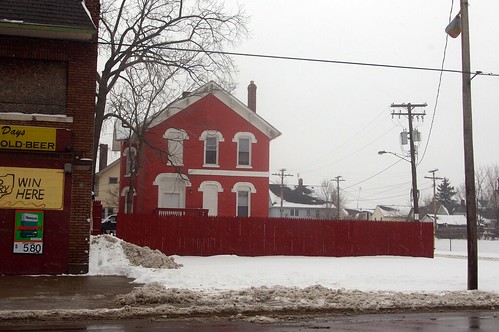
This is what you would have seen until a year or so ago at 9915 Miles Avenue, in Cleveland. Another nondescript single-story brick commercial building.

This is the same spot today. The demolition of the commercial building on Miles Avenue revealed this circa 1880 brick Second Empire style house.

The house, which the County Auditor lists at 4166 East 100th Street, appears to be in good condition on the exterior. Making it again visible to passersby on the main thoroughfare improves the quality of the streetscape as well as illustrating the past of this neighborhood and road.
There are a surprising number of buildings like this in the greater Cleveland area. Most of the older roads have become major commercial routes, so residences become commercial properties. The commercial properties are usually physically connected to the residences, rather than being placed in front of them.
We are at a point in time at which there are many buildings being considered for demolition within the city. We need to carefully consider which buildings we will save and which we will allow to be bulldozed. If there's only a slight commercial advantage to a business using a less interesting building, we should consider incentives to encourage them to save the more interesting ones.




I have to agree with you, the structure was definitely demolished for the greater good!
ReplyDeleteThe house at 9915 Miles/4166 E 100th St is quite handsome and provides a wonderful example of its locally popular class. Thanks for bringing this to our attention! Let’s hope that increased visibility is a small step toward house survival and neighborhood resurgence.
ReplyDeleteIt would be useful to discuss the house’s style from a base other than that of national style (in this case, described as Second Empire). There are ways to describe Western Reserve house style in more intimate and regionally sensitive terms. Unfortunately, such a discussion is too long and complex for a blog comment. More regionally focused style frameworks help us better understand our regional and local identities.